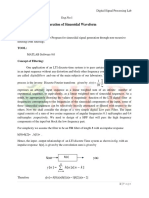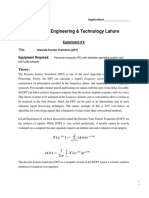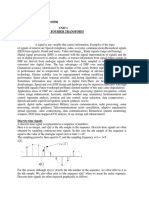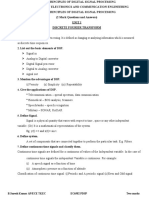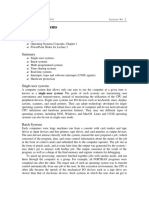National University of Modern Languages, Islamabad Communication System Lab
National University of Modern Languages, Islamabad Communication System Lab
Uploaded by
ImMalikCopyright:
Available Formats
National University of Modern Languages, Islamabad Communication System Lab
National University of Modern Languages, Islamabad Communication System Lab
Uploaded by
ImMalikOriginal Description:
Original Title
Copyright
Available Formats
Share this document
Did you find this document useful?
Is this content inappropriate?
Copyright:
Available Formats
National University of Modern Languages, Islamabad Communication System Lab
National University of Modern Languages, Islamabad Communication System Lab
Uploaded by
ImMalikCopyright:
Available Formats
National University of Modern Languages,
Islamabad
Communication System Lab
EXPERIMENT # 02: Convolution, Correlation and DFT
Name of Student: …………………………………..
Roll No.: ……………………………………………
Date of Experiment: ………………………………..
Report submitted on: ………………………………..
Marks obtained: ……………………………………
Remarks: ……………………………………………
Instructor’s Signature: …………………………….....
Department of Engineering, NUML, Islamabad Page 1
Lab Session 2
Convolution, Correlation and DFT
Objective
1. Analysis of convolution of different signals
2. Analysis of correlation of different signals
3. To find the Discrete Fourier Transform of a different sinusoidal sequence.
Convolution
Definition of convolution
The convolution sum describes the relationship between the input and output of discrete-time system, and
is easily evaluated to a compute as a sum of products of numbers.
To perform discrete time convolution, x[n]*h[n], define the vectors x and h with elements in the
sequences x[n] and h[n].
Then use the command
y = conv(x,h)
This command assumes that the first element in x and the first element in h correspond to n = 0, so that
the first element in the resulting output vector corresponds to n = 0 . If this is not the case, then the output
vector will be computed correctly, but the index will have to be adjusted.
Example
>> x = [1 1 1 1 1];
>> h = [0 1 2 3];
>> y = conv(x,h)
Result of conv of x and y is
y=
Columns 1 through 7
0 1 3 6 6 6 5
Column 8
Department of Engineering, NUML, Islamabad Page 2
Cross correlation
Cross-correlations are useful for determining the time delay between two signals, e.g. for determining
time delays for the propagation of acoustic signals across a microphone array.After calculating the cross-
correlation between the two signals, the maximum of the cross-correlation function indicates the point in
time where the signals are best aligned,
f= xcorr(x,y) returns the cross-correlation sequence in a length 2*N-1 vector, where x and y are length N
vectors (N>1). If x and y are not the same length, the shorter vector is zero-padded to the length of the
longer vector.
DEFINITION OF 'AUTOCORRELATION'
A mathematical representation of the degree of similarity between a given time series and a lagged
version of itself over successive time intervals.
DEFINITION OF DFT AND IDFT
The Fourier transform takes a signal in the so called time domain (where each sample in the signal is
associated with a time) and maps it, without loss of information, into the frequency domain. The
frequency domain representation is exactly the same signal, in a different form. The inverse Fourier
transform maps the signal back from the frequency domain into the time domain.
A time domain signal will usually consist of a set of real values, where each value has an associated time
(e.g., the signal consists of a time series). The Fourier transform maps the time series into a a frequency
domain series, where each value is a complex number that is associated with a given frequency. The
inverse Fourier transform takes the frequency series of complex values and maps them back into the
original time series. Assuming that the original time series consisted of real values, the result of the IDFT
will be complex numbers where the imaginary part is zero.
GENERATION OF DISCRETE FOURIER TRANSFORM (DFT) OF A SEQUENCE
In this program the Discrete Fourier Transform
(DFT) of a sequence x[n] is generated by using the formula,
N-1
X(k) = Σ x(n) e -2πjk / N
Where, X(k) DFT of sequence x[n]
n=0
N represents the sequence length and it is calculated by using the command ‘length’. The DFT of any
sequence is the powerful computational tool for performing frequency analysis of discrete-time signals.
MATLAB CODE :
clc;
clear all;
close all;
a=input('Enter the sequence :');
N=length(a);
disp('The length of the sequence is:');N
Department of Engineering, NUML, Islamabad Page 3
for k=1:N
y(k)=0;
for i=1:N
y(k)=y(k)+a(i)*exp((-2*pi*j/N)*((i-1)*(k-1)));
end;
end;
k=1:N
disp('The result is:');y
figure(1);
subplot(211);
stem(k,abs(y(k)));
grid;
xlabel('sample values n-->');
ylabel('Amplitudes-->');
title('Mangnitude response of the DFT of given sequence');
subplot(212);
stem(angle(y(k))*180/pi);
grid;
xlabel('sample values n-->');
ylabel('phase-->');
title('Phase response of the DFT of given sequence');
Magnitude and phase response of DFT
GENERATION OF INVERSE DISCRETE FOURIER TRANSFORM (IDFT) OF A SEQUENCE
PROGRAM DESCRIPTION :
In this program the Inverse Discrete Fourier Transform ( IDFT ) of a sequence X(k) is generated by using
the formula,
N-1
x [n] = Σ X(k) e 2πjk/N
Where, x[n] IDFT of sequence X (k)
Department of Engineering, NUML, Islamabad Page 4
n=0
N represents the sequence length and it is calculated by using the command ‘length’.
The IDFT results in the sequence from its DFT.
MATLAB CODE :
clc;
clear all;
close all;
a=input('Enter the sequence :');
N=length(a);
disp('The length of the sequence is:');N
for n=1:N
y(n)=0;
for k=1:N
y(n)=y(n)+a(k)*exp((2*pi*j*(k-1)*(n-1))/N);
end;
end;
n=1:N
y1=1/N*y(n);
disp('The result is:');y1
figure(1);
stem(n,y1);
grid;
xlabel('sample values n-->');
ylabel('Amplitudes-->');
title('Mangnitude response of the IDFT of given DFT');
Inverse DFT results
FINDING THE FFT OF DIFFERENT SIGNALS
Fast Fourier transform (FFT) algorithm computes the discrete Fourier transform (DFT) of a sequence,
or its inverse. Fourier analysis converts a signal from its original domain (often time or space) to a
representation in the frequency domain and vice versa.
PROGRAM DESCRIPTION: In this program using the command FFT for impulse response. In the
process of finding the FFT the length of the FFT is taken as N. The FFT consists of two parts:
Department of Engineering, NUML, Islamabad Page 5
MAGNITUDE PLOT and PHASE PLOT. The magnitude plot is the absolute value of magnitude versus
the samples and the phase plot is the phase angle versus the samples.
MATLAB CODE:
clc;
clear all;
close all;
%impulse sequence
t=-2:1:2;
y=[zeros(1,2) 1 zeros(1,2)];
subplot (3,1,1);
stem(t,y);
grid;
input('y=');
disp(y);
title ('Impulse Response');
xlabel ('time -->');
ylabel ('--> Amplitude');
xn=y;
N=input('enter the length of the FFT sequence: ');
xk=fft(xn,N);
magxk=abs(xk);
angxk=angle(xk);
k=0:N-1;
subplot(3,1,2);
stem(k,magxk);
grid;
xlabel('k');
ylabel('|x(k)|');
subplot(3,1,3);
stem(k,angxk);
disp(xk);
grid;
xlabel('k');
ylabel('arg(x(k))');
Command window
y=[1 2 3 4]
0 0 1 0 0
enter the length of the FFT sequence: 8
Columns 1 through 4
1.0000 0 - 1.0000i -1.0000 0 + 1.0000i
Columns 5 through 8
1.0000 0 - 1.0000i -1.0000 0 + 1.0000i
Department of Engineering, NUML, Islamabad Page 6
Output graph
Lab task
1) Compute cross-correlation of the sequences
x=[1, 2, 3, 4] and h=[4, 3, 2, 1]
2) Compute auto-correlation of sequence of any random vector of length 6
3) Compute discrete Fourier transform(fft)
X(n)= n 0<=n<8
Exercise
Q1:
Consider the analog signal xa(t) given by
a) Xa(t)=3cos(2000πt)+ 5sin(6000πt)+ cos(8000πt)
Plot it in matlab
b) Compute the autocorrelation of Xa(t) and plot it.
Without using matlab command (try to do it with loop)
c) Explain Relation between convolution and correlation
Q2:
Compute discrete Fourier transform (fft) using the command FFT for step, ramp and
exponential sequences .Plot input signal its magnitude and phase angles.
Department of Engineering, NUML, Islamabad Page 7
You might also like
- A Foster Network Thermal Model For HEV/EV Battery ModelingDocument8 pagesA Foster Network Thermal Model For HEV/EV Battery Modelingal-masriNo ratings yet
- Experiments1 5Document15 pagesExperiments1 5Sameer ShaikhNo ratings yet
- Dsip Lab Manual Latest UpdatedDocument39 pagesDsip Lab Manual Latest Updatedmanas dhumalNo ratings yet
- Lab 8Document8 pagesLab 8shajib19No ratings yet
- Lab 3 DSP. Discrete Fourier TransformDocument16 pagesLab 3 DSP. Discrete Fourier TransformTrí TừNo ratings yet
- EXPERIMENT3Document7 pagesEXPERIMENT3Sanjith PranavNo ratings yet
- Netaji Subhas University of Technology New Delhi: Data Communication Practical FileDocument17 pagesNetaji Subhas University of Technology New Delhi: Data Communication Practical FileDK SHARMANo ratings yet
- Lab 10-Descrete Fourier Transform and Circular ConvolutionDocument8 pagesLab 10-Descrete Fourier Transform and Circular ConvolutionAleena QureshiNo ratings yet
- Lab Manaual 07: University of Engineering and Technology, TaxilaDocument13 pagesLab Manaual 07: University of Engineering and Technology, TaxilaMuhammad HassaanNo ratings yet
- Ece603 Unified Electronics Laboratory Lab ManualDocument39 pagesEce603 Unified Electronics Laboratory Lab ManualSuneel JaganNo ratings yet
- The Hong Kong Polytechnic University Department of Electronic and Information EngineeringDocument4 pagesThe Hong Kong Polytechnic University Department of Electronic and Information EngineeringNiaz ManikNo ratings yet
- DSP-Manual - R19Document74 pagesDSP-Manual - R19Ragha RamojuNo ratings yet
- Digital Signal Processing NotesDocument159 pagesDigital Signal Processing NotesuttamNo ratings yet
- Exp 1Document5 pagesExp 1Santhoshkumar R PNo ratings yet
- Rajshahi University of Engineering & TechnologyDocument5 pagesRajshahi University of Engineering & Technologyabirf2003No ratings yet
- Cs2403 - Digital Signal Processing Unit-I Signals & SystemsDocument18 pagesCs2403 - Digital Signal Processing Unit-I Signals & SystemsSuresh DskNo ratings yet
- Ece Odd9Document17 pagesEce Odd9Venkat MuruganNo ratings yet
- DSP PracticalDocument25 pagesDSP PracticalDurgesh DhoreNo ratings yet
- Netaji Subhas University of Technology New Delhi: Department of Electronics and Communications EngineeringDocument26 pagesNetaji Subhas University of Technology New Delhi: Department of Electronics and Communications EngineeringDK SHARMANo ratings yet
- Digital Signal Processing Two MarksDocument11 pagesDigital Signal Processing Two MarksDelphin ShibinNo ratings yet
- 2 Marks Questions & Answers: Cs-73 Digital Signal Processing Iv Year / Vii Semester CseDocument18 pages2 Marks Questions & Answers: Cs-73 Digital Signal Processing Iv Year / Vii Semester Csehariharankalyan100% (1)
- DSP Lab ManualDocument75 pagesDSP Lab ManualRyan951No ratings yet
- S and S ReportDocument7 pagesS and S ReportVishal PhadtareNo ratings yet
- 2 Marks Questions & Answers: Cs-73 Digital Signal Processing Iv Year / Vii Semester CseDocument18 pages2 Marks Questions & Answers: Cs-73 Digital Signal Processing Iv Year / Vii Semester CseprawinpsgNo ratings yet
- DTSP 2marks PDFDocument20 pagesDTSP 2marks PDFishuNo ratings yet
- Lab 9Document9 pagesLab 9Ahtisham aliNo ratings yet
- EC8553 2marksDocument20 pagesEC8553 2marksSNo ratings yet
- Unit I - Discrete Fourier Transform Part - ADocument10 pagesUnit I - Discrete Fourier Transform Part - AindhuNo ratings yet
- U19ec129 Pcs Labsheet1Document18 pagesU19ec129 Pcs Labsheet1dhanyasri1819No ratings yet
- DSP Lab ReportDocument22 pagesDSP Lab ReportMd AshikNo ratings yet
- Unit-4 - Kec503 DSP - 2023-24Document34 pagesUnit-4 - Kec503 DSP - 2023-24shubhNo ratings yet
- DSP Lecture NotesDocument24 pagesDSP Lecture Notesvinothvin86No ratings yet
- DSP LAB MANUAL (R16) SVEB-JNTU - K-Converted-1Document23 pagesDSP LAB MANUAL (R16) SVEB-JNTU - K-Converted-1Siva sai VenkateshNo ratings yet
- DSP Complete ManualDocument59 pagesDSP Complete ManualAnonymous Q6WJ2JUNo ratings yet
- Manual For DSP LAB 3rd YearDocument53 pagesManual For DSP LAB 3rd YearVinay ChandraNo ratings yet
- DSP Lab Manual Final Presidency UniversityDocument58 pagesDSP Lab Manual Final Presidency UniversitySUNIL KUMAR0% (1)
- DSP Lab Manual 5 Semester Electronics and Communication EngineeringDocument147 pagesDSP Lab Manual 5 Semester Electronics and Communication Engineeringrupa_123No ratings yet
- DSP Lab Expt 4 Manual EECE GITAM-24-32Document9 pagesDSP Lab Expt 4 Manual EECE GITAM-24-32gowri thumburNo ratings yet
- Lab2-Spectral Analysis in MatlabDocument14 pagesLab2-Spectral Analysis in MatlabindameantimeNo ratings yet
- Time and Frequency Analysis of Discrete-Time SignalsDocument15 pagesTime and Frequency Analysis of Discrete-Time SignalsVinay Krishna VadlamudiNo ratings yet
- B.Suresh Kumar Ap/Ece Tkec Ec6502 PDSP Two MarksDocument14 pagesB.Suresh Kumar Ap/Ece Tkec Ec6502 PDSP Two MarksSuresh KumarNo ratings yet
- Digital Signal Processing Important 2 Two Mark Question and Answer IT 1252Document14 pagesDigital Signal Processing Important 2 Two Mark Question and Answer IT 1252startedforfunNo ratings yet
- TE (ICE) Signals and Systems Lab ManualDocument16 pagesTE (ICE) Signals and Systems Lab ManualPreeti KatiyarNo ratings yet
- EC-504 - Aritra DuttaDocument6 pagesEC-504 - Aritra DuttaAritraNo ratings yet
- 7 SS Lab ManualDocument34 pages7 SS Lab ManualELECTRONICS COMMUNICATION ENGINEERING BRANCHNo ratings yet
- DSP 2 Marks Q&a1Document38 pagesDSP 2 Marks Q&a1shankarNo ratings yet
- 097 3Document8 pages097 3Ashish BeckhamNo ratings yet
- Spectral Analysis Lab 1Document18 pagesSpectral Analysis Lab 1ali aminNo ratings yet
- DSP Two Marks - Unit I-IVDocument27 pagesDSP Two Marks - Unit I-IVDhariniNo ratings yet
- ECE Lab 2 102Document28 pagesECE Lab 2 102azimylabsNo ratings yet
- DSP Report DSPDocument49 pagesDSP Report DSProckettekcorNo ratings yet
- Digital Signal Processing: Name: Roll No: AimDocument11 pagesDigital Signal Processing: Name: Roll No: AimCharmil GandhiNo ratings yet
- DSP Lab Report # 04Document23 pagesDSP Lab Report # 04Abdul BasitNo ratings yet
- Green's Function Estimates for Lattice Schrödinger Operators and ApplicationsFrom EverandGreen's Function Estimates for Lattice Schrödinger Operators and ApplicationsNo ratings yet
- Fundamentals of Electronics 3: Discrete-time Signals and Systems, and Quantized Level SystemsFrom EverandFundamentals of Electronics 3: Discrete-time Signals and Systems, and Quantized Level SystemsNo ratings yet
- Student Solutions Manual to Accompany Economic Dynamics in Discrete Time, second editionFrom EverandStudent Solutions Manual to Accompany Economic Dynamics in Discrete Time, second editionRating: 4.5 out of 5 stars4.5/5 (2)
- Measurements-Based Radar Signature Modeling: An Analysis FrameworkFrom EverandMeasurements-Based Radar Signature Modeling: An Analysis FrameworkNo ratings yet
- Software Radio: Sampling Rate Selection, Design and SynchronizationFrom EverandSoftware Radio: Sampling Rate Selection, Design and SynchronizationNo ratings yet
- Analyzing Neural Time Series Data: Theory and PracticeFrom EverandAnalyzing Neural Time Series Data: Theory and PracticeRating: 4 out of 5 stars4/5 (4)
- Operating Systems Lecture No. 2: Reading MaterialDocument6 pagesOperating Systems Lecture No. 2: Reading MaterialImMalikNo ratings yet
- Experiment 9 Implement Multistage Cascode and Cascade Amplifier ObjectiveDocument4 pagesExperiment 9 Implement Multistage Cascode and Cascade Amplifier ObjectiveImMalikNo ratings yet
- ECD Lab 7 PDFDocument3 pagesECD Lab 7 PDFImMalikNo ratings yet
- ECD Lab 7Document3 pagesECD Lab 7ImMalikNo ratings yet
- DSP Lectures v2 (Chapter2)Document32 pagesDSP Lectures v2 (Chapter2)vvvssssvvv100% (1)
- Picture Processing by Computer Azriel Rosenfeld: University of Maryland, College Park, MarylandDocument28 pagesPicture Processing by Computer Azriel Rosenfeld: University of Maryland, College Park, MarylandJohn WestonNo ratings yet
- AEMx CH15Document56 pagesAEMx CH15林茂泉No ratings yet
- Iterative Methods of Richardson-Lucy-type For Image DeblurringDocument15 pagesIterative Methods of Richardson-Lucy-type For Image DeblurringhilmanmuntahaNo ratings yet
- Tables of Convolution Integrals: A.B. ArbuzovDocument13 pagesTables of Convolution Integrals: A.B. Arbuzovsai420No ratings yet
- Instant Download Signals Systems and Transforms Fifth Edition Parr PDF All ChapterDocument60 pagesInstant Download Signals Systems and Transforms Fifth Edition Parr PDF All Chaptersoziohugesni100% (10)
- DSP 1Document4 pagesDSP 1Pavan KulkarniNo ratings yet
- SS-2-Marks Questions With AnswersDocument12 pagesSS-2-Marks Questions With AnswersPasupuleti Venkata RamanaNo ratings yet
- 2402.05427 Sameera SincDocument25 pages2402.05427 Sameera SincChamin HewaNo ratings yet
- Dose Calculation AlgorithmDocument22 pagesDose Calculation AlgorithmEdis Đedović100% (1)
- Exm Opencl Tdfir Optimization GuideDocument42 pagesExm Opencl Tdfir Optimization GuideHadji MhamedNo ratings yet
- Fourier Transform, Convolution, Z-Transform MCQDocument25 pagesFourier Transform, Convolution, Z-Transform MCQShivam Pandey100% (1)
- 3.4 Fundamentals of Spatial Filtering: FilterDocument18 pages3.4 Fundamentals of Spatial Filtering: FilterPYCNo ratings yet
- S & S 2 MarksDocument30 pagesS & S 2 MarkspriyajegaNo ratings yet
- Brief Introduction of Mobilenetv1 V2 V3 Lightweight NetworkDocument29 pagesBrief Introduction of Mobilenetv1 V2 V3 Lightweight Networkadalberto soplatetasNo ratings yet
- DSP Question Bank With SolutionsDocument46 pagesDSP Question Bank With Solutionsazhagumuruganr73% (22)
- Integral EquationsDocument46 pagesIntegral EquationsNirantar YakthumbaNo ratings yet
- Convolucion DiscretaDocument11 pagesConvolucion DiscretaDel FinNo ratings yet
- EEE415 Digital Image Processing: Frequency Domain FilteringDocument50 pagesEEE415 Digital Image Processing: Frequency Domain FilteringFAISAL NAWABNo ratings yet
- Consolidated Report.Document30 pagesConsolidated Report.Hemant JhaNo ratings yet
- Fourier Transforms by R.C. JENNISONDocument126 pagesFourier Transforms by R.C. JENNISONThe Negative AngleNo ratings yet
- Signals and Systems Lab 3: Convolution Discrete Time ConvolutionDocument14 pagesSignals and Systems Lab 3: Convolution Discrete Time ConvolutionMR. SONU RATHINo ratings yet
- Digital Signal Processing4.4Document19 pagesDigital Signal Processing4.4Khushi SidNo ratings yet
- Lesson PlanDocument8 pagesLesson PlanPalani PicoNo ratings yet
- Water RudinDocument7 pagesWater Rudintgabi2012No ratings yet
- From Characteristic Function PDFDocument11 pagesFrom Characteristic Function PDFE-tecCeará-MirimNo ratings yet
- Spectral Content of NRZ Test PatternsDocument5 pagesSpectral Content of NRZ Test PatternsRohan RajagopalNo ratings yet
- Inclusions and Noninclusions of Spaces of Multipliers of Some Wiener Amalgam SpacesDocument16 pagesInclusions and Noninclusions of Spaces of Multipliers of Some Wiener Amalgam SpacesInforma.azNo ratings yet
- Signals and Systems PDFDocument4 pagesSignals and Systems PDFkalaNo ratings yet





















